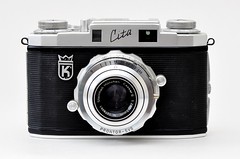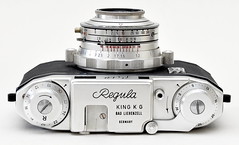Difference between revisions of "Regula Cita"
Hanskerensky (talk | contribs) m (→Links: Refined Link URL) |
|||
| (4 intermediate revisions by 3 users not shown) | |||
| Line 27: | Line 27: | ||
'''[[Lens]]:''' [[Zeiss]] Tessar 50mm f/2.8 | '''[[Lens]]:''' [[Zeiss]] Tessar 50mm f/2.8 | ||
| − | '''[[Shutter]]:''' Prontor-SVS | + | '''[[Shutter]]:''' Prontor-SVS centrally-mounted leaf shutter |
'''[[Shutter speed]] range:''' 1s-1/300th + B | '''[[Shutter speed]] range:''' 1s-1/300th + B | ||
| + | |||
| + | '''[[Flash sync]]:''' X and M, all speeds. | ||
'''Focus areas:''' 1m-Infinity | '''Focus areas:''' 1m-Infinity | ||
| − | '''[[Viewfinder]]:''' | + | '''[[Viewfinder]]:''' Reverse telescopic type with superimposed rangefinder |
| − | '''ASA/ISO range:''' 6-200 | + | '''ASA/ISO range: (of film speed reminder)''' 6-200 |
|} | |} | ||
| − | [[King]]'s '''Regula Cita''' was a German 35mm [[rangefinder camera]]. It was launched in 1954. The camera was a quite modern design, with rapid film advance lever and optical viewfinder with superimposed coupled rangefinder. It was equipped with [[Steinheil]] Cassar 1:2.8/45mm lens and [[Prontor]]-SVS leaf shutter. In the USA it was sold as the '''King Regula Gipsy''' but with the lens/shutter style used on the later Regula III series cameras, the German distributor [[Porst]] sold it as '''Hapo 36'''. | + | [[King]]'s '''Regula Cita''' was a German 35mm fixed-lens [[rangefinder camera]]. It was launched in 1954. The camera was a quite modern design for King at the time, with rapid film advance lever and optical viewfinder with superimposed coupled rangefinder. Like most of the Regula cameras up to this point, it had a compact and lightweight aluminum body with a nylon leatherette. However, it was the first Regula with a coupled rangefinder (some previous models had the superimposed rangefinder but no coupling between the finder and lens.) It had other conveniences such as a switch that allowed the film to be advanced without firing the shutter (for more quickly loading the camera), PC socket, cold shoe, film type reminder (in DIN) and a large, easy-loading Bakelite take-up spool. |
| − | + | ||
| + | The leaf shutter is a very common one seen on many similar cameras. It has M and X sync, switchable, although M is not usable with the self timer as they are controlled by the same lever and probably use the same gearing. | ||
| + | |||
| + | The advance lever is also a remarkable convenience for the era, but must be advanced in one motion or it will fail to cock the shutter, unlike many contemporary cameras with the advance lever, which can freely be advanced in several strokes or one. | ||
| + | |||
| + | It was most commonly equipped with [[Steinheil]] Cassar 1:2.8/45mm lens and [[Prontor]]-SVS leaf shutter. In the USA it was sold as the '''King Regula Gipsy''' but with the lens/shutter style used on the later Regula III series cameras, the German distributor [[Porst]] sold it as '''Hapo 36'''. | ||
| + | |||
{{Flickr_image | {{Flickr_image | ||
|image_source=http://www.flickr.com/photos/10456228@N00/4599294232/in/pool-camerawiki | |image_source=http://www.flickr.com/photos/10456228@N00/4599294232/in/pool-camerawiki | ||
| Line 56: | Line 64: | ||
|image_rights= with permission | |image_rights= with permission | ||
}} | }} | ||
| − | |||
| − | |||
| − | |||
| − | |||
| − | |||
| − | |||
| − | |||
| − | |||
| − | |||
| − | |||
| − | |||
| − | |||
| − | |||
| − | |||
| − | |||
| − | |||
| − | |||
| − | |||
| − | |||
| − | |||
| − | |||
| − | |||
| − | |||
| − | |||
| − | |||
{{Flickr_image | {{Flickr_image | ||
| Line 92: | Line 75: | ||
== Regula Citalux 300 == | == Regula Citalux 300 == | ||
| − | |||
| − | |||
| − | |||
| − | |||
| − | |||
| − | |||
| − | |||
'''Manufacturer:''' [[King]] | '''Manufacturer:''' [[King]] | ||
| Line 121: | Line 97: | ||
'''ASA/ISO range:''' 6-200 | '''ASA/ISO range:''' 6-200 | ||
| − | + | ||
[[King]]'s '''Regula Citalux 300''' was a German 35mm [[rangefinder camera]] launched in 1956. The camera was the same as the standard Cita equipped with [[Steinheil]] Cassar 1:2.8/45mm lens and [[Prontor]]-SVS leaf shutter. The camera was covered in red leather, the metal was gold plated and sold in a luxury box lined with silk and velvet covered in red leather, one of the camera's accessories was a golden chain. | [[King]]'s '''Regula Citalux 300''' was a German 35mm [[rangefinder camera]] launched in 1956. The camera was the same as the standard Cita equipped with [[Steinheil]] Cassar 1:2.8/45mm lens and [[Prontor]]-SVS leaf shutter. The camera was covered in red leather, the metal was gold plated and sold in a luxury box lined with silk and velvet covered in red leather, one of the camera's accessories was a golden chain. | ||
| Line 129: | Line 105: | ||
==Links== | ==Links== | ||
| + | * [https://www.butkus.org/chinon/regula/regula_guide/regula_guide.htm Regula user manuals] at [https://www.butkus.org/chinon/ Butkus.org] | ||
* [http://www.kamera-geschichte.de/files/hapo36_d.htm HAPO 36] at [http://www.kamera-geschichte.de/ kamera-geschichte.de] | * [http://www.kamera-geschichte.de/files/hapo36_d.htm HAPO 36] at [http://www.kamera-geschichte.de/ kamera-geschichte.de] | ||
Latest revision as of 17:14, 16 April 2024
Regula Cita
| Regula Cita | ||
|---|---|---|
Manufacturer: King Date of Production: 1954-56 Type of Camera: Rangefinder Film Type: 35mm Lens: Steinheil Cassar 45mm f/2.8 Shutter: Prontor-SVS centrally-mounted leaf shutter Shutter speed range: 1s-1/300th + B Flash sync: X and M, all speeds. Focus areas: 1m-Infinity Viewfinder: Reverse telescopic type with superimposed rangefinder ASA/ISO range: (of film speed reminder) 6-200 |
King's Regula Cita was a German 35mm fixed-lens rangefinder camera. It was launched in 1954. The camera was a quite modern design for King at the time, with rapid film advance lever and optical viewfinder with superimposed coupled rangefinder. Like most of the Regula cameras up to this point, it had a compact and lightweight aluminum body with a nylon leatherette. However, it was the first Regula with a coupled rangefinder (some previous models had the superimposed rangefinder but no coupling between the finder and lens.) It had other conveniences such as a switch that allowed the film to be advanced without firing the shutter (for more quickly loading the camera), PC socket, cold shoe, film type reminder (in DIN) and a large, easy-loading Bakelite take-up spool.
The leaf shutter is a very common one seen on many similar cameras. It has M and X sync, switchable, although M is not usable with the self timer as they are controlled by the same lever and probably use the same gearing.
The advance lever is also a remarkable convenience for the era, but must be advanced in one motion or it will fail to cock the shutter, unlike many contemporary cameras with the advance lever, which can freely be advanced in several strokes or one.
It was most commonly equipped with Steinheil Cassar 1:2.8/45mm lens and Prontor-SVS leaf shutter. In the USA it was sold as the King Regula Gipsy but with the lens/shutter style used on the later Regula III series cameras, the German distributor Porst sold it as Hapo 36.

|
| Cita with Cassar lens image by Morinaka. (Image rights) |

|
| Regula Cita - Top Section image by Morinaka. (Image rights) |

|
| Porst Hapo 36 image by gorkola (Image rights) |
Regula Citalux 300
Manufacturer: King
Date of Production: 1956
Type of Camera: Rangefinder
Film Type: 35mm
Lens: Steinheil Cassar 45mm f/2.8
Shutter: Prontor-SVS
Shutter speed range: 1s-1/300th + B
Focus areas: 1m-Infinity
Viewfinder: Yes
ASA/ISO range: 6-200
King's Regula Citalux 300 was a German 35mm rangefinder camera launched in 1956. The camera was the same as the standard Cita equipped with Steinheil Cassar 1:2.8/45mm lens and Prontor-SVS leaf shutter. The camera was covered in red leather, the metal was gold plated and sold in a luxury box lined with silk and velvet covered in red leather, one of the camera's accessories was a golden chain.
The name of the camera comes from its price of 300DM which was a lot of money at the time. Using the exchange rate for DM to British pounds in 1956, and using the British national archives old British currency converter, the conversion of 300DM in 1956 to April 2010 rates is around £440 (British pounds) or $675 (US dollars). To put that in perspective a modern consumer level DSLR camera with a kit lens is around £480-500.
